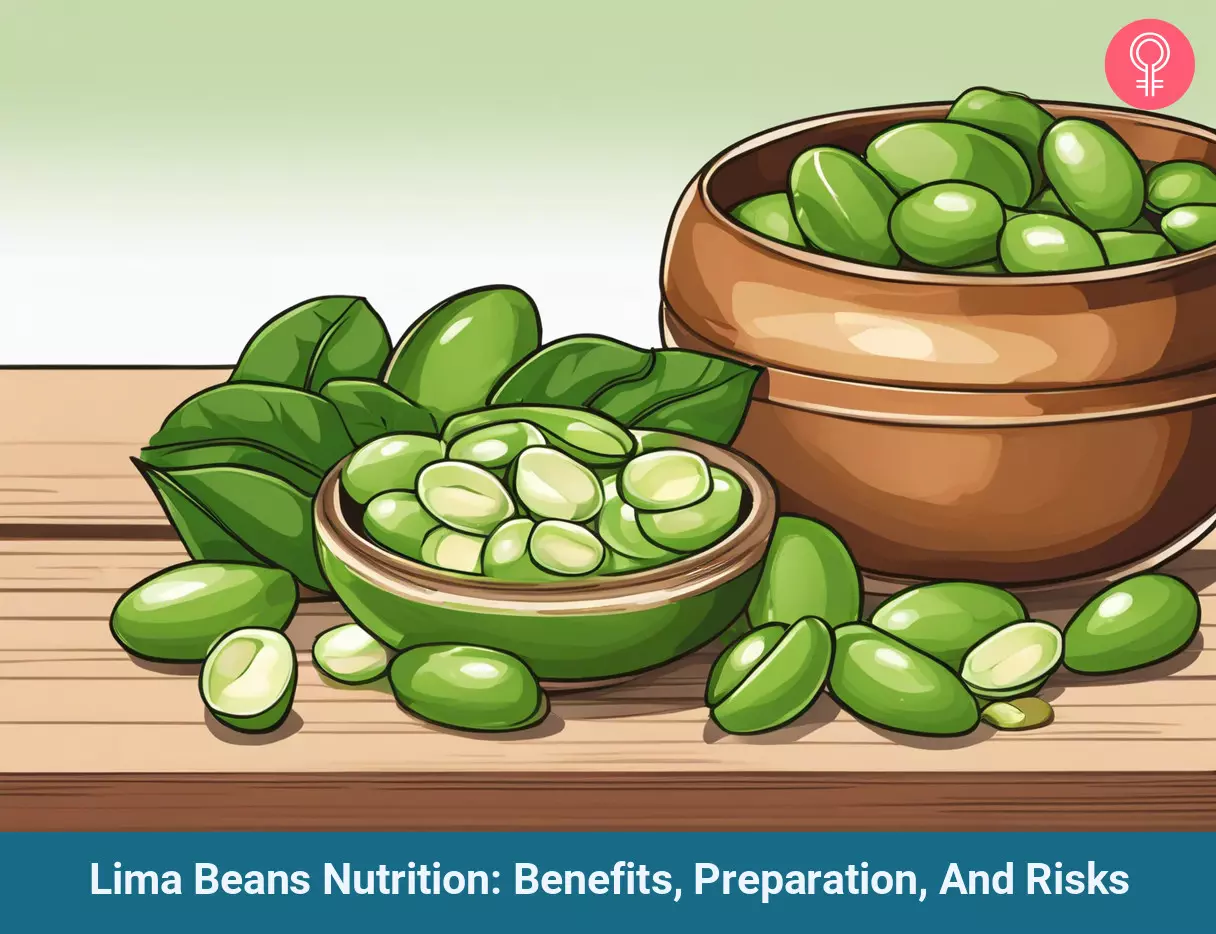What Are Lima Beans?
Lima beans (Phaseolus lunatus) are also commonly known as butter beans or sieva beans. They are a legume grown for their edible seeds or beans. They are oval and whitish or green. They have a buttery taste and are among the most common legumes consumed all over the world. What Are Its Benefits? It may support digestive health, reduce cholesterol levels, and regulate blood sugar levels. Who Can Use It? Considered safe for consumption in general. How Often? Regularly. Caution Excess consumption may lead to gastrointestinal discomfort. Avoid consuming it if you are allergic to legumes.
Lima beans are available in different types and cultivars. We briefly discuss them below.
Types Of Lima Beans
Lima beans are available in a diverse array of varieties based on where they grow. Overall, they come in two sizes, small and large, and are further classified into pole and bush types. These beans can adapt to diverse climates. Their rich, buttery taste makes them versatile and a delicious addition to many home gardens across the globe. Lima beans thrive in the Southern United States and are often referred to as butter beans. The favored cultivars in this region include Nemagreen, Jackson Wonder, Sieva Pole, and Henderson Bush beans. In contrast, the Northern regions are less accommodating to lima bean cultivation. People here typically opt for small-seeded bush varieties like Dixie Butterpea, Thorogreen, and Thaxter. Are you wondering, “are lima beans good for you?” Find out in the next section.
What Are The Health Benefits Of Lima Beans?
1. May Help With Weight Control
Lima beans are a good source of dietary fiber. They also are a fat-free source of high-quality protein. They increase satiety (short term) and help with weight loss during international energy restriction (1). Thus, substituting them for energy-dense foods may help with weight management. A review published in the Journal of the Obesity Reviews suggests that consuming legumes can help reduce the risk of obesity-related co-morbidities such as metabolic syndromei Cluster of multiple health disorders that elevate the risk of developing heart disease, insulin resistance, and neurological problems. , diabetes, and cardiovascular disease (2). However, more research is needed to further understand the role of lima beans in weight loss and weight management.
2. May Improve Digestive Health
Scientific studies have linked the consumption of dietary fiber with the growth of good bacteria in the colon (3). Dietary fiber is well known for its impact on digestion. It helps bulk up the stool and stimulates peristaltic motioni A succession of involuntary muscular contractions that transport food through the digestive system. and optimizes nutrient uptake. The high dietary fiber in lima beans can be beneficial for gut health and the digestive system. It can help reduce the risk of acid reflux, ulcers, constipation, diarrhea, and hemorrhoidsi A condition where the rectum and anus veins are swollen and irritated, resulting in pain and bleeding. (4).
3. May Have Cardioprotective Effects
The fiber in lima beans helps lower blood cholesterol levels. They also are a good source of folate. Folate is associated with lower homocysteine levels. Elevated homocysteine is known to increase the risk of coronary heart disease (5).
4. May Help Stabilize Blood Sugar Levels
Scientific studies show that consuming legumes like lima beans can help regulate blood sugar in people with diabetes (6). This could be attributed to their low glycemic index and higher dietary fiber content (6). However, more studies are needed to further understand the role of lima beans in this regard.
Lima Beans Nutrition Facts
One cup of raw lima beans (156g) have the following nutrients (7):
Calories: 176 Fat: 1.3g Sodium: 12.5mg Carbohydrates: 31.5g Fiber: 7.6g Sugars: 2.3g Protein: 10.7g
Lima Beans Preparation And Tips
Lima beans are usually available frozen, dried, or canned. Pick what suits your requirements. You can buy them shelled or unshelled. Fresh lima beans can be stored in the refrigerator for a week. Dried, shelled beans can last up to a year in a cool, dry place. Look for whole, uncracked lime beans. Avoid dried or discolored beans.
How to Prepare Shell lima beans before you cook them by opening each pod and removing the beans. Rinse the beans in a colander before cooking. Add the beans to boiling salt water to cook them fresh. Cook until tender, up to 60 minutes. The mild buttery taste of these beans pairs well with fish, meat, poultry, or grains. Lima beans can easily be added to soups, salads, casseroles, a bean mash, or a dip recipe. You can also use lima beans in place of other beans, like white beans. You can also check out the following lima bean recipes.
Lemon-Garlic Lima Beans
You Will Need
1 pound dried lima beans 2 bay leaves 3 tablespoons extra virgin olive oil, divided 1 medium onion, chopped 4 garlic cloves, thinly sliced 1/4 cup chopped fresh parsley 2 tablespoons lemon juice 1 tablespoon chopped fresh oregano 2 teaspoons grated lemon zest 1/2 teaspoon salt 1/4 teaspoon pepper Additional chopped fresh parsley
Process
Southern Lima Beans
You Will Need
1 pound large dried lima beans 1 large smoked ham hock 9 cups water 1 1/2 teaspoons salt 1/2 teaspoon black pepper
Process
Saucy Lima Beans
You Will Need
11/2 cup frozen lima beans 1/4 cup chopped onion 1 tablespoon butter 2/3 cup half-and-half cream 11/2 teaspoons minced fresh parsley 1/2 teaspoon dill weed 1/4 teaspoon salt 1/8 teaspoon pepper
Process Including lima beans in your food is quite easy. But you must be aware of their potential adverse effects before you start consuming them.
Lima Beans Health Risks
May Cause Allergies
Individuals allergic to legumes and peanuts may develop allergic reactions to lima beans. Direct research on allergies to lima beans is lacking. However, legume allergies may trigger mild skin reactions or even life-threatening anaphylactic reactionsi Potentially fatal allergic reaction that develops seconds or minutes after allergen exposure and causes difficulty breathing or shock – and have been reported in people exposed to legumes and peanuts (8).
Has A Risk Of Cyanide Poisoning
Lima beans contain cyanogenic glycosides that can be hydrolyzed into the highly toxic hydrogen cyanide(9). Though this is rare, it is better to be cautious while consuming large amounts of raw lima beans.
May Cause Gastrointestinal Discomfort
Lima beans contain oligosaccharides that can cause flatulence (9). Do consult a doctor if you experience nausea, vomiting, stomach cramps, or diarrhea after consuming lima beans.
May Reduce The Absorption Of Certain Nutrients
Lima beans contain compounds (called anti-nutrients, like lectins and tannins) that may interfere with the absorption of nutrients (10), (11). However, rinsing, cooking, and toasting the beans may help reduce the concentrations of these antinutrients. People with malnutrition or anemia should consult a nutritionist before consuming lima beans. Are lima beans good for hair? Anecdotal evidence suggests that lima beans help promote hair growth. However, limited research is available to prove these claims. Are lima beans anti-inflammatory? Yes. Lima beans, which are also known as dried beans, are rich in antioxidants that may act against inflammation and free radical damage (12). Are lima beans good for your kidneys? Yes. The presence of plant protein in lima beans helps reduce the risk of kidney disease (13). However, more studies are warranted to prove these claims. Are lima beans high in potassium? Yes. Lima beans are rich in potassium. One cup of raw lima beans contains 729 mg of potassium (7).
Illustration: Lima Beans Nutrition: Benefits Preparation And Risks
Learn about the amazing nutrition and health benefits of lima beans. Watch this video to discover how this superfood can help you stay healthy and fit. Reference code












